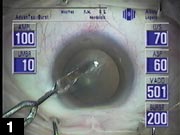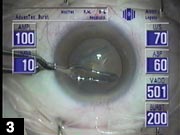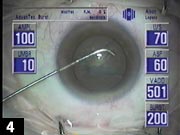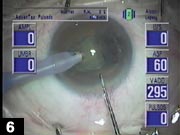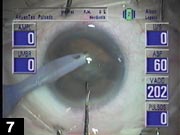V-prechop: a simplified and safer technique for cataract surgery
This modification of the original Akahoshi technique allows better visualization and avoids rotation of the nucleus, developer says.
| Comparison of Akahoshi and V-chop techniques
Source: Viteri E. |
The phaco prechop, a surgical technique originally described by Takayaku Akahoshi, MD, in 1993, is a highly efficient method for removing cataracts. Using this method a surgeon can fracture the nucleus under viscoelastic without grooving or sculpting, reducing not only the ultrasound energy delivered but also intraocular irrigation, both of which are traumatic to the corneal endothelium.
Several instruments and techniques have been designed by Dr. Akahoshi to deal with soft to hard cataracts. In the hands of Dr. Akahoshi and other high-volume surgeons, the technique looks quite easy. However, even the most skilled of eye surgeons may have difficulty and quit the technique after trying it a few times. The following V-chop modification is easier to learn and perform, and retains the efficiency and safety of the conventional technique.
Difficulties with conventional prechop
The original prechop technique can present several difficulties.
The anterior chamber can be filled by a mix of cortical material and viscoelastic during the hydrodissection or the rotation of the nucleus.
During the conventional procedure the surgeon may be afraid to introduce the prechopper deep into the nucleus. As a result, if the instrument is opened too superficially, the cortex can disintegrate, causing the surgeon to loose sight and control of the fracture procedure.
Even if the surgeon had successfully achieved the first longitudinal fracture, during the second rotation the viscoelastic can become opaque. This can be handled by aspirating the cortex and refilling the anterior chamber with viscoelastic, but this will prolong the procedure and make it more expensive, an important consideration in developing countries.
The surgeon can expulse the viscoelastic from the anterior chamber during the irrigation, during the rotation maneuvers or during the fracturing maneuvers. Sometimes repeated refilling of the anterior segment is required, with the cost and time considerations already expressed.
In addition, incomplete fracture may occur, usually a consequence of poor visualization and the natural fear to go deep in the nucleus with the tip of the prechopper.
V-prechop surgical steps
I developed a variation of the original Akahoshi surgical procedure to simplify the technique and make it safer for grade 1 to 3 nuclei. Visualization is not compromised by performing the oblique fractures of the nucleus before the hydrodissection and eliminating the rotation step.
The pertinent surgical steps are performed in the following manner.
Corneal paracentesis is performed. The anterior chamber is filled with Viscoat and Provisc using the soft shell technique. Capsulorrhexis is performed as usual.
An initial oblique (not radial) nucleus fracture is made using a prechopper. In phacorefractive or grade 1 to 2 nuclei I use the Akahoshi Combo Prechopper. In harder nuclei I use the Universal Akahoshi Prechopper with or without counter pressure.
A second oblique fracture that forms a V with the previous fracture is made, with the vertices of the V pointing to the center of the corneal incision.
Hydrodissection is performed using an angulated cannula. The central fragment is expulsed from the capsular bag and projected to the pupillary plane. If a complete fracture is not obtained, the pressure of the liquid can be enough to break apart the three pieces.
The emulsification and aspiration of the central fragment may now begin easily as it is free in the pupillary plane. The remaining peripheral segments are rotated with the nucleus manipulator or chopper of your preference, emulsified and aspirated. Irrigation and aspiration of the cortical remnants is performed either bimanually or with a coaxial handpiece.
The IOL is then implanted in the capsular bag.
This technique is well-suited for phacorefractive cases. In the case pictured here, an AcrySof ReStor pseudoaccommodative lens is inserted using a B-Cartridge and a No. 6 lacrimal probe.
|
|
|
|
|
|
| All images courtesy of Eduardo Viteri, MD. | |
Comparison of techniques
Dr. Akahoshi states several important prerequisites for the prechop technique. Sufficient hydrodissection must be performed so that the nucleus rotates freely in the capsular bag before inserting the prechopper. The blade should always be inserted along the direction of the lens fibers, and four similar pie-like segments, one for every quadrant, should be created.
The V-prechop technique is executed by inserting the blade in an oblique direction. One V-shaped central segment and two crescent-like segments are formed, after which hydrodissection is performed until the fluid pressure pushes the central segment forward to the pupillary plane. As the fragments obtained with the V-prechop are larger than in the conventional prechop, extra fractures are needed (a W-prechop) to deal with harder nuclei.
It is quite common to hear from colleagues that, after attending a conference or surgical demonstration by Dr. Akahoshi, they went immediately to get the necessary instruments. However, after trying his technique a few times, they return to their previous surgical technique. The main complaint is the lack of good visibility and the flattening of the anterior chamber during several of the surgical steps. Some of these surgeons that could not complete the prechop told me that they gave the V-prechop modification a try and found it easier to perform.
|
|
|
|
|
|
Indications for the V-prechop
With the advent of accommodative and pseudoaccommodative lenses we are in need of surgical procedures that are increasingly safe and efficient. The conventional prechop techniques are well-known for being among the most efficient procedures available to remove the crystalline lens. By making it simpler and safer, I consider this V-prechop modification one more step in the right direction.
The V-chop technique is easier to learn and perform than the conventional or karate prechop techniques, especially in grade 1 to 3 nuclei. At the same time, it retains the main benefit of reducing ultrasound energy and surgical time. As you do not need to rotate the nucleus, I also prefer it in some difficult cases like pseudoexfoliation syndrome or eyes with a history of uveitis, ocular trauma or posterior vitrectomy. Finally, it is rarely necessary to refill the anterior chamber with viscoelastic, an important advantage in developing countries.
For Your Information:
Reference
- Eduardo Viteri, MD, can be reached at Humana Visión, Panamá 616 y Roca, Consultorio 301, Guayaquil, Ecuador; 5934-2303573; e-mail: eviteri@ecuadorlaser.com; Web site: www.ecuadorlaser.com.
- Akahoshi T: Phaco prechop: Manual nucleofracture prior to phacoemulsification. Op Tech Cataract Ref Surg. 1998;1:69-91.

